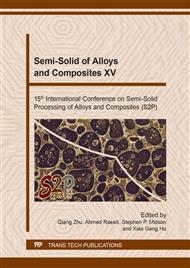p.12
p.24
p.33
p.39
p.45
p.51
p.57
p.63
p.69
Microstructural Evolution of SKD11 Tool Steel during Multi-Stage Thixoforming and Subsequent Heat Treatments
Abstract:
The application of semisolid forming (SSF) is inhibited significantly by the inhomogeneous distributions of microstructure and mechanical properties in the products manufactured by SSF. Beside of forming parameters including forming temperature, isothermal holding time, and forming speed, post heat treatments of SSF is one of the most important facts affecting the microstructure and mechanical properties of the SSF-manufactured products. In this study, heat treatments including annealing, quenching, and tempering different experimental conditions were conducted on the SKD11 tool steel samples manufactured by multi-stage thixoforming with different forming parameters. The microstructures in different regions of specimen processed by different experimental conditions were investigated by using a field-emission scanning electron microscopy (FE-SEM), an energy-dispersive X-ray spectroscopy (EDS), and X-ray diffractometer (XRD). Base on the results of microstructural analyses, the microstructural evolution of SKD11 tool steel during multi-stage thixoforming and subsequent heat treatments with varies experimental parameters were discussed and summarized. Meanwhile, the relationship between microstructure and mechanical properties of SKD11 tool steel processed by multi-stage thixoforming and subsequent heat treatment was also discussed.
Info:
Periodical:
Pages:
45-50
Citation:
Online since:
January 2019
Authors:
Keywords:
Price:
Сopyright:
© 2019 Trans Tech Publications Ltd. All Rights Reserved
Share:
Citation:


